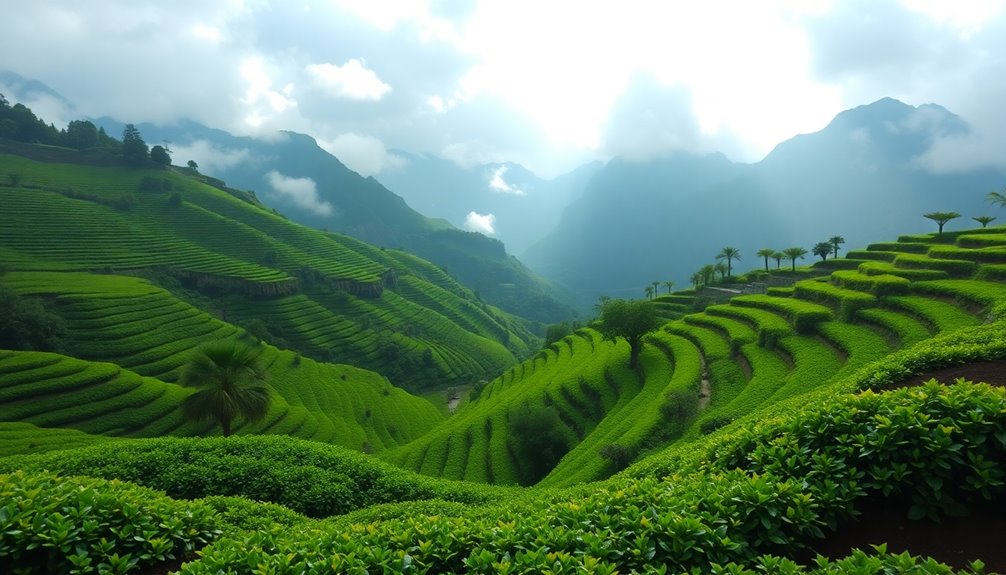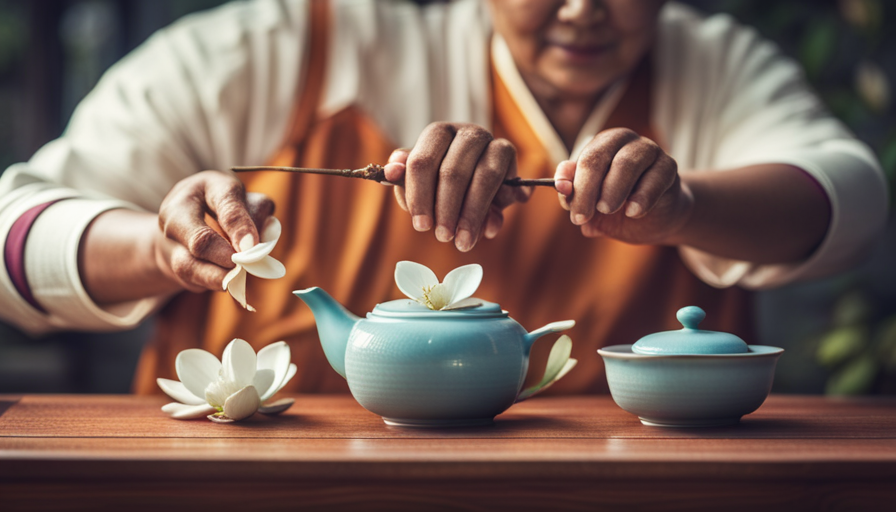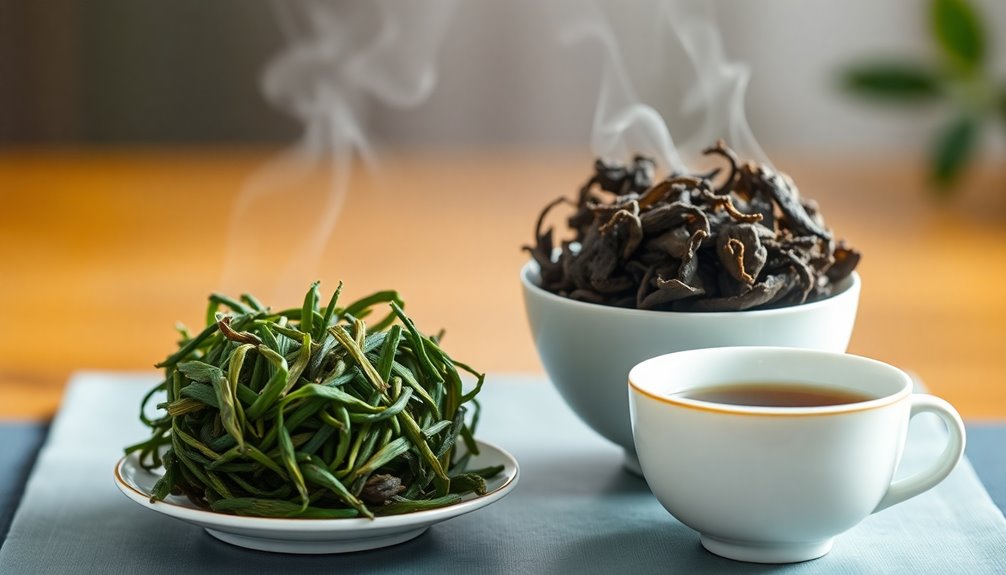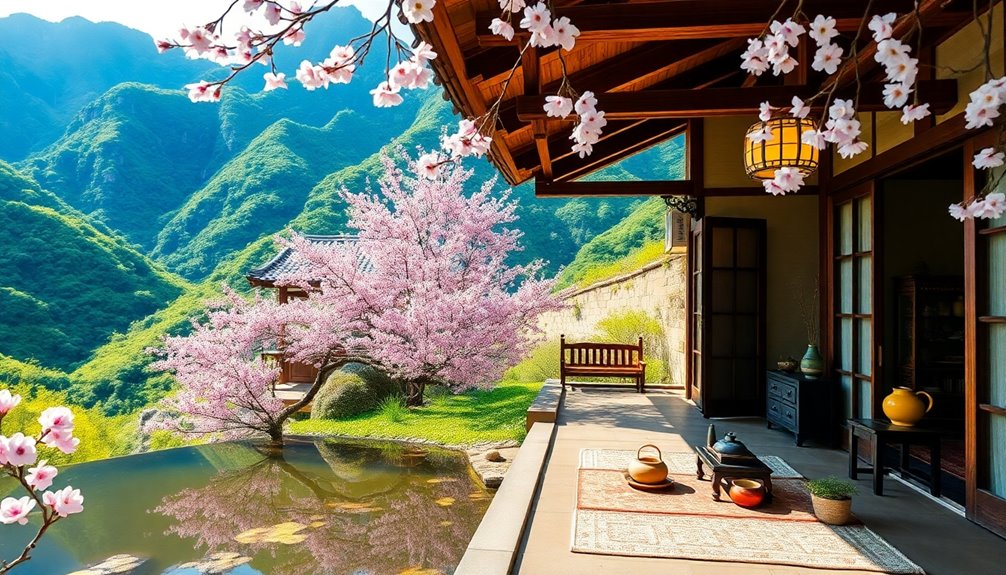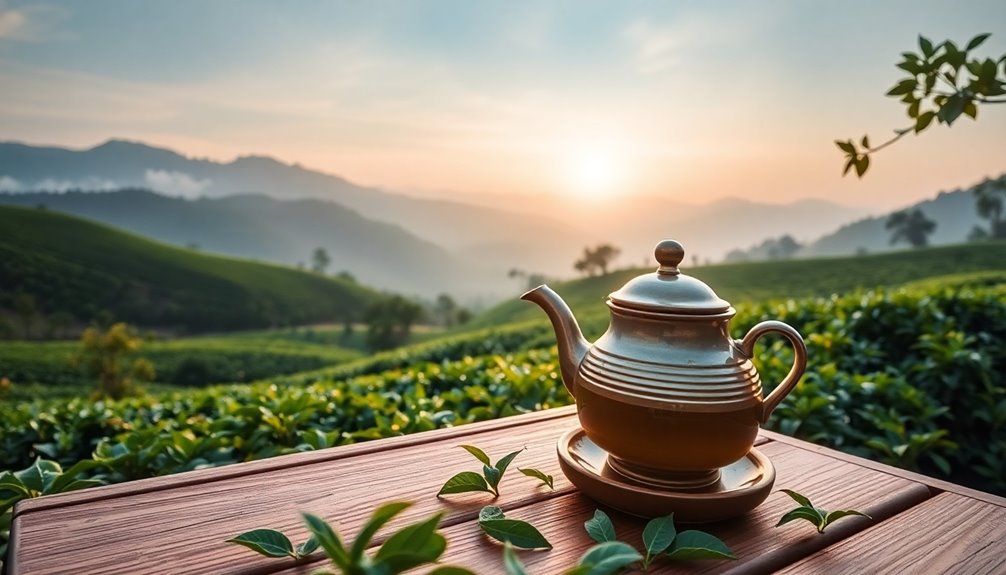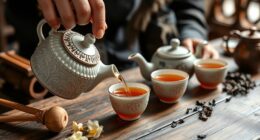Taiwanese tea grows in a magical mix of high mountains, rich soil, and perfect weather! You'll find tea thriving where:
- Fertile plains meet towering mountains, creating unique spots for plants.
- A subtropical climate with lots of rain helps tea flourish.
- Cooler mountain areas slow growth for better flavors.
- Volcanic soil and organic farming boost taste too!
Handpicked with care, these teas come to life with special processing techniques. Plus, strict regulations ensure safe, flavorful tea for everyone. Isn't that exciting? Keep discovering the wonders of Taiwanese tea and its delightful journey!
Key Takeaways
- Taiwan's subtropical climate, with an average annual rainfall of 2,500 mm, provides optimal conditions for tea cultivation.
- High-altitude regions, like Ali Shan, enhance tea flavors due to cooler temperatures and increased sunlight.
- Volcanic and alluvial soil compositions contribute essential minerals and nutrients, influencing tea taste.
- Distinct microclimates across Taiwan create unique flavor profiles through temperature fluctuations and misty conditions.
- Organic farming practices and traditional harvesting methods ensure high-quality tea while promoting environmental sustainability.
Introduction
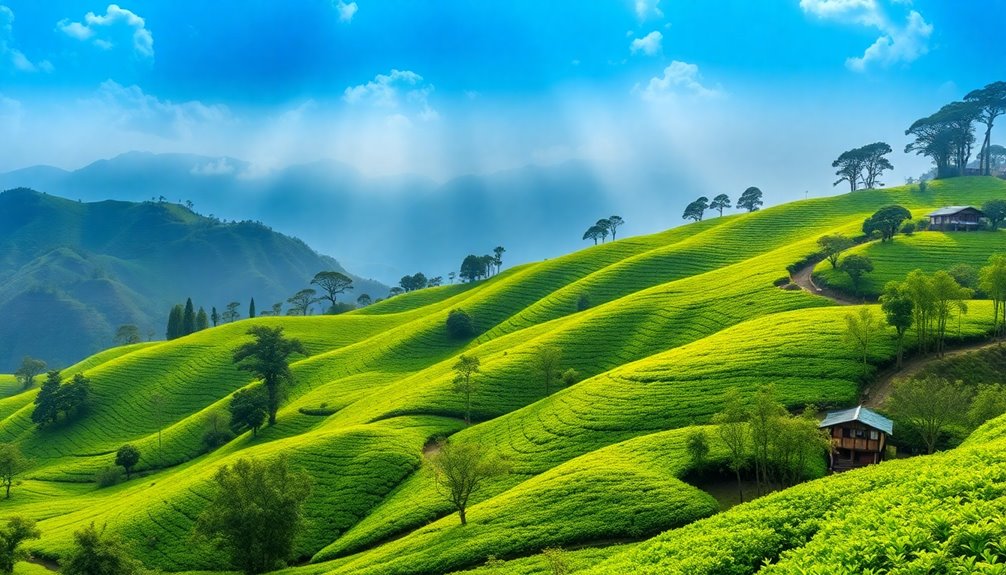
Taiwan's lush landscapes, where fertile plains meet towering mountains, create a perfect environment for growing tea. You'll find that Taiwan's unique geography features mountainous terrain, which gives rise to diverse microclimates. These microclimates are essential for producing high mountain teas, each with its special flavor profiles. Imagine sipping a cup of tea that captures the essence of its surroundings!
In regions like Nantou County and Chiayi County, the cooler mountain climate makes a big difference. Temperature variations can reach up to 20°C (45°F) between the mountains and the plains. This cooler climate slows down the growth of tea plants, allowing them to develop richer aromas and flavors.
The abundant rainfall and humidity from the maritime climate help the tea plants thrive, adding to their delightful taste. High mountain teas from areas like Ali Shan and Li Shan benefit from mist and fog, creating unique growing conditions.
These factors come together to shape the wonderful teas you might enjoy, each sip telling a story of Taiwan's beautiful landscapes. So, the next time you drink Taiwanese tea, remember the special place it comes from!
High Altitude Tea Cultivation
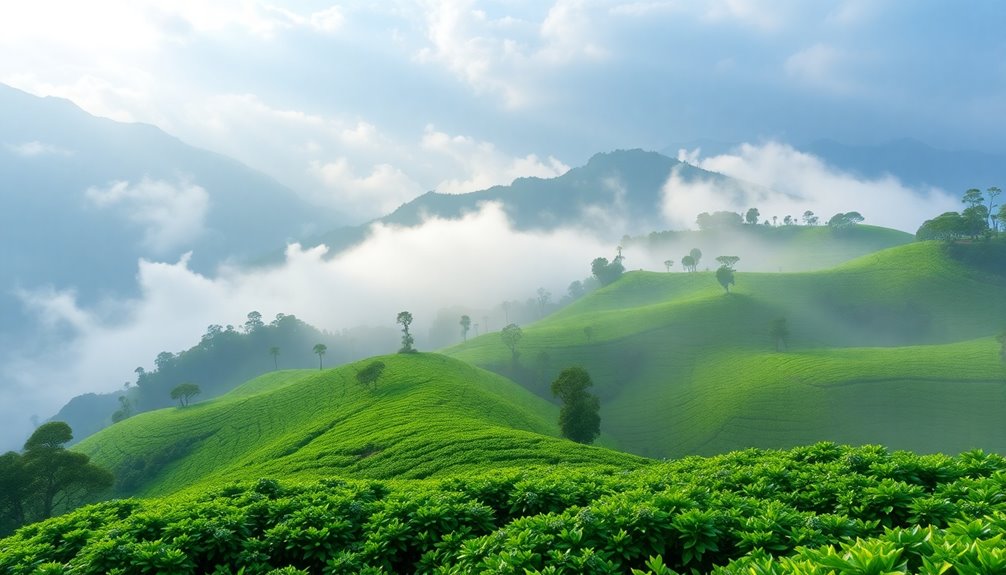
High-altitude tea cultivation thrives in Taiwan's mountainous regions, where elevations of 1,000 to 1,200 meters create ideal conditions for tea plants. Here, the cooler temperatures slow down plant growth, allowing them to develop complex flavors that tea lovers adore.
The unique microclimates in places like Ali Shan and Li Shan produce sought-after oolong tea, famous for its floral and buttery notes.
In these high-altitude areas, tea plants bask in increased sunlight, which boosts the levels of catechins and other beneficial compounds. This means you get better tea quality!
The mountainous terrain, along with foggy conditions, acts like a cozy blanket, naturally protecting the plants from pesky pests. This allows for organic farming practices, making your tea not just delicious but also healthier.
Harvesting usually happens in spring and autumn, and skilled farmers hand-pick the leaves. This careful selection ensures that only the best leaves make it into your cup.
Microclimates Influence Flavor Profiles
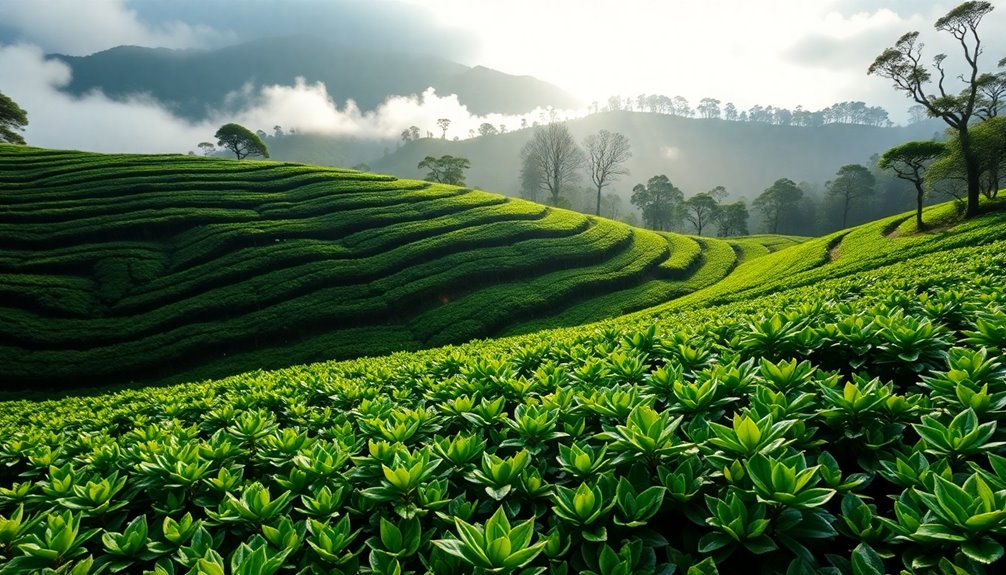
Distinct microclimates across Taiwan's mountainous regions shape the unique flavor profiles of its teas. When you sip Taiwanese oolong varieties, you're tasting the magic of these microclimates! High-altitude areas like Alishan and Li Shan enjoy cooler temperatures and fog. This special weather creates aromatic and complex flavors that make each cup a delightful surprise.
Here's how it all comes together:
- Temperature Fluctuations: These changes help develop specific taste characteristics. You'll find floral notes in High Mountain Oolong that dance on your palate!
- Humidity Levels: The moist air adds a layer of freshness to the tea, making it even more enjoyable.
- Mineral Compositions: Different soil types affect the minerals in the tea leaves. This diversity enhances the nuanced flavors you find in each sip.
Take Dong Ding Oolong, for example. It has a rich and smooth flavor due to Nantou County's warm maritime climate.
In contrast, the Alishan region produces teas with a fresh and buttery profile. Each cup is like a tiny adventure waiting to be savored! Enjoy exploring the delightful flavors of Taiwanese tea!
Biodiversity in Tea Ecosystems
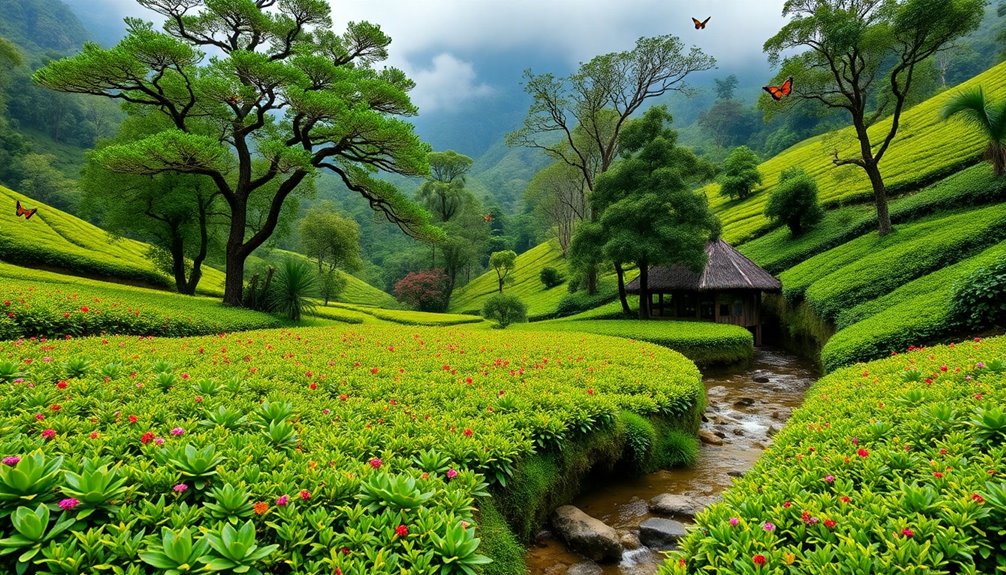
The rich biodiversity found in Taiwan's tea ecosystems plays a significant role in shaping the unique flavor profiles of its teas. When you explore these beautiful landscapes, you'll notice how different tea cultivars grow in various conditions.
For instance, high elevation teas often have a distinct taste compared to those grown in lowland areas.
Here are some exciting facts about Taiwan's tea biodiversity:
- Variety of Cultivars: The Taiwanese tea industry mainly features the Qingxin cultivar, but you'll also find Jinxuan and Sijicun, each offering unique flavors.
- Organic Farming: Many farmers are turning to organic and sustainable practices. This helps support biodiversity and keeps our environment healthy!
- Native Flora: The island is home to native plants and helpful insects, which benefit tea plants and enhance taste, especially in specialty teas like Oriental Beauty.
- Soil Composition: Different areas have unique soils, such as volcanic or alluvial, affecting the nutrients available to tea plants.
Pesticide Use and Regulations
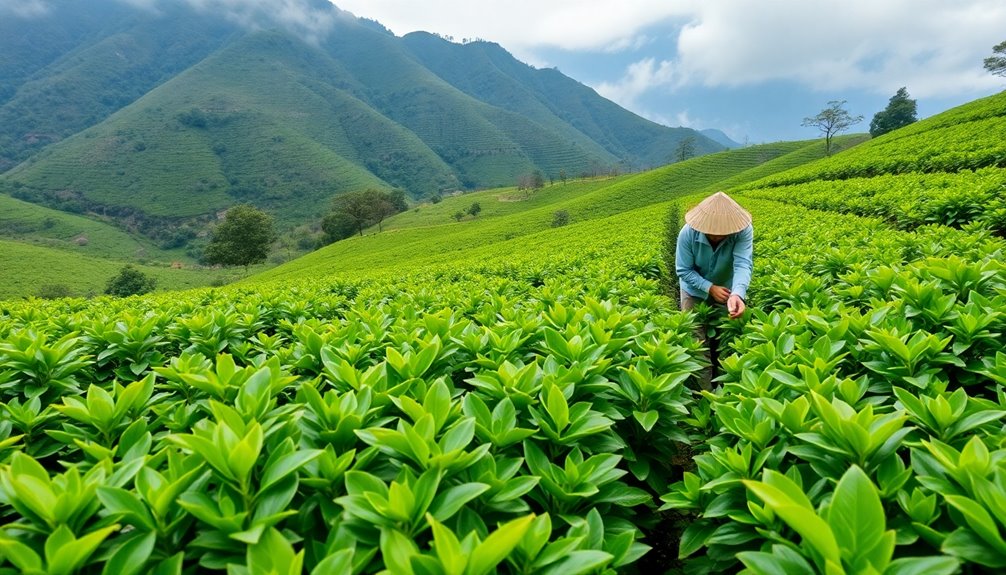
Pesticide use in Taiwan's tea industry is closely regulated to ensure both safety and quality. The Pesticide Management Act sets strict pesticide regulations that tea producers must follow. This means they can only use certain types of pesticides and must apply them carefully. It's all about keeping your tea safe and delicious!
More and more farmers are turning to organic farming practices, with over 20% of Taiwan's tea farms certified organic as of 2022. This shows their commitment to eco-friendly cultivation!
To keep tea healthy and safe, the Taiwan Agricultural Chemicals and Toxic Substances Research Institute (TACTSRI) checks for pesticide residues in tea products, making sure they meet health standards.
Farmers are also encouraged to join Integrated Pest Management (IPM) programs. These programs focus on biological control methods and reduce the use of chemical pesticides, promoting environmental health.
Plus, education and training programs help tea growers learn safe pesticide handling and application, minimizing risks in tea cultivation.
Additionally, the adoption of Integrated Pest Management strategies enhances sustainability efforts in the agricultural sector.
With all these efforts, you can enjoy your cup of Taiwanese tea, knowing it's produced with care for both you and the planet!
Practical Applications
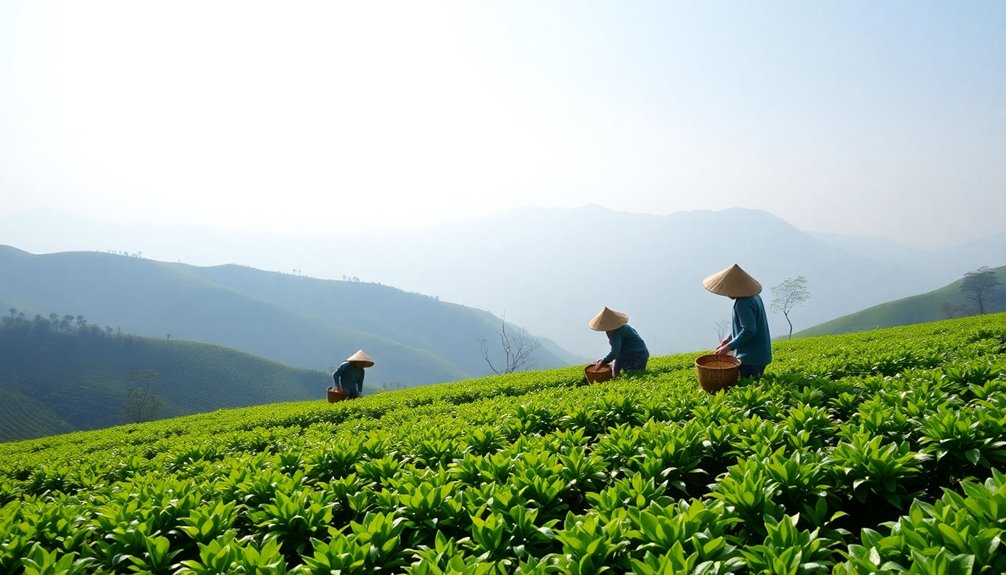
In the heart of Taiwan's tea regions, the unique growing conditions translate directly into practical applications for both farmers and tea enthusiasts. The mountainous terrain and cooler temperatures create the perfect environment for growing Taiwanese Oolong tea.
You'll find high mountain oolong that shines thanks to the unique microclimates of places like Alishan and Dong Ding. These areas offer a variety of flavor profiles, from floral to nutty, making every cup a delightful surprise! The essential oils for mental clarity found in the region's flora can also enhance the sensory experience while enjoying the tea. Additionally, the omega-3 content of chia seeds can provide health benefits that complement the experience of sipping high-quality tea. Studies show a significant reduction in stress levels among users of aromatherapy, which can further enhance relaxation while enjoying a comforting cup of tea. Chia seeds' high fiber content also promotes digestive health, making them a great addition to a balanced diet.
Farmers use hand-picking methods during spring and autumn, ensuring only the finest leaves make it into your tea pot. This careful selection dramatically impacts the quality and taste of the tea.
Plus, many farmers are adopting organic farming practices to preserve the ecological balance, so you can feel good about sipping your tea. Chia seeds and digestive health are also influenced by similar careful agricultural practices, highlighting the importance of sustainable farming methods.
Here's why these practices matter:
- Flavor Profiles: Cooler temperatures enhance rich flavors.
- Hand-Picking: Only the best leaves are chosen.
- Organic Farming: Protects the environment and taste.
Frequently Asked Questions
What Are Ideal Tea Growing Conditions?
Ideal tea growing conditions include a mild maritime climate, high humidity, rich soil, and regular rainfall. Elevation enhances flavor by slowing growth, while mist protects plants, ensuring robust qualities in the final product.
What Kind of Tea Is Grown in Taiwan?
In Taiwan, you'll find a variety of teas, including renowned oolong types like Dong Ding and High Mountain Oolong, as well as black teas like Sun Moon Lake. Each offers unique flavors and aromas.
What Is the Difference Between Chinese and Taiwanese Tea?
Chinese tea offers a broad range of varieties, while Taiwanese tea focuses mainly on oolong. You'll find Taiwanese tea emphasizes unique processing and high-quality flavors, setting it apart from the diverse Chinese tea landscape.
What Is the History of Tea in Taiwan?
You'll discover that tea cultivation in Taiwan began in the 17th century, advanced during Japanese rule, and flourished post-World War II. By the 1980s, citizens could establish tea factories, enhancing production and quality.
Conclusion
In conclusion, Taiwan's tea is truly special! The high-altitude farms, unique microclimates, and rich biodiversity all come together to create amazing flavors. Plus, with careful pesticide use and smart rules, tea-growers keep their plants safe and healthy. So next time you sip a warm cup of Taiwanese tea, remember the wonderful journey it took to get to you. It's not just tea; it's a taste of Taiwan's beautiful nature and hard work! Enjoy every drop!

